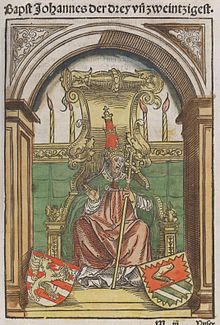
Back Teenpous Johannes XXIII Afrikaans Johannes (XXIII.) ALS يوحنا التالت و العشرين (بابا الفاتيكان) ARZ Йоан XXIII (антипапа) Bulgarian Yann XXIII (eneppab) Breton Joan XXIII de Pisa Catalan Jan XXIII. (vzdoropapež) Czech Gwrth-bab Ioan XXIII Welsh Modpave Johannes 23. Danish Johannes XXIII. (Gegenpapst) German
John XXIII | |
|---|---|
 Miniature from the Chronicle of the Council of Constance by Ulrich of Richenthal | |
| Elected | 17 May 1410 |
| Papacy began | 25 May 1410 |
| Papacy ended | 29 May 1415 |
| Predecessor | Roman claimant: Gregory XII Antipapal claimant: Pisan Alexander V Avignonian Benedict XIII |
| Successor | Roman claimant: Gregory XII Antipapal claimant: Avignonian Benedict XIII Florentine Felix V |
| Opposed to | Roman claimant: Pope Gregory XII Antipapal (Avignon) claimant: Antipope Benedict XIII |
| Orders | |
| Ordination | 24 May 1410 by Jean-Allarmet de Brogny |
| Consecration | 25 May 1410 by Jean-Allarmet de Brogny |
| Created cardinal | 27 February 1402 by Pope Boniface IX |
| Rank | Cardinal-Deacon |
| Personal details | |
| Born | Baldassarre Cossa |
| Died | 1419 Florence, Republic of Florence |
| Buried | Tomb of Antipope John XXIII |
| Alma mater | University of Bologna |
| Coat of arms | |
| Other popes and antipopes named John | |
Baldassarre Cossa (died 22 December 1419) was Pisan antipope as John XXIII (1410–1415) during the Western Schism. The Catholic Church today regards him as an antipope in opposition to Pope Gregory XII, whom it recognizes as the rightful successor of Saint Peter. John XXIII was also an opponent of Benedict XIII, who was recognized by the French clergy and monarchy as the legitimate pope.
Historically, the Annuario Pontificio recognized John XXIII the legitimate successor of Saint Peter.[1] However, the Western Schism was reinterpreted when Pope John XXIII chose to reuse the ordinal XXIII, which is now reflected in modern editions of the Annuario Pontificio.[2] John XXIII is now considered to be an antipope and Gregory XII's reign is recognized to have extended until 1415.
Cossa was born in the Kingdom of Naples. In 1403, he served as a papal legate in Romagna. He participated in the Council of Pisa in 1408, which sought to end the Western Schism with the election of a third alternative pope. In 1410, he succeeded Antipope Alexander V, taking the name John XXIII. At the instigation of King Sigismund of Germany, Pope John called the Council of Constance of 1413, which deposed John XXIII and Benedict XIII, accepted Gregory XII's resignation, and elected Pope Martin V to replace them, thus ending the schism. John XXIII was tried for various crimes, though later accounts question the veracity of those accusations. Towards the end of his life Cossa restored his relationship with the Church and was made Cardinal Bishop of Frascati by Pope Martin V.
- ^ Annuario pontificio per l'anno 1942. Rome. 1942. p. 21.
205. Gregorio XII, Veneto, Correr (c. 1406, cessò a. 1409, m. 1417) – Pont. a. 2, m. 6. g. 4. 206. Alessandro V, dell'Isola di Candia, Filargo (c. 1409, m. 1410). – Pont. m. 10, g. 8. 207. Giovanni XXII o XXIII o XXIV, Napoletano, Cossa (c. 1410, cessò dal pontificare 29 mag. 1415)
{{cite book}}: CS1 maint: location missing publisher (link) - ^ "I Choose John ..." Time. 10 November 1958. p. 91.